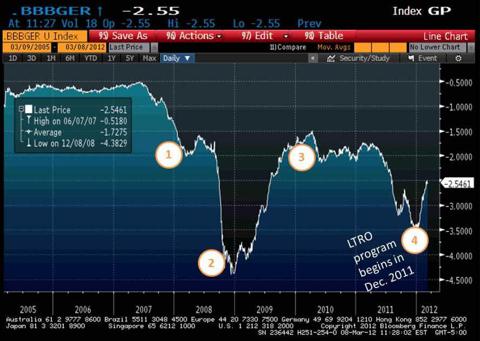Since the European debt crisis began some three years ago, it has taken many twists and turns. In December of 2011, the European Central Bank (ECB) initiated the Long-Term Refinancing Operation (LTRO) — which is the European equivalent of the Troubled Asset Relief Program, or TARP, launched in the United States in the immediate wake of the financial crisis of 2008. Through the LTRO the ECB has lent out €529.5 billion ($712.81 billion) in cheap, three-year loans to about 800 lenders. So what exactly is the LTRO, and how did it work?
In effect, the LTRO is a state-sponsored carry trade designed to reduce interest rates more broadly in Europe and in the peripheral sovereign debt in particular. Another phrase for carry trade is yield curve speculation in which an investor (in this case a bank or financial institution) borrows short term at low rates and lends (or buys bonds) longer term at greater yielding rates — thereby earning a spread. The reason it is speculative is because there is typically no assurance that the asset will produce the income stream it is expected to produce, or more to the point, there is no assurance that rates will remain low — in such case the long-term asset (bond, loan, etc.) would decline markedly in value and short-term borrowing costs could rise markedly, thereby squeezing the investor and possibly turning the spread from profit to loss.
To gain some perspective on the crisis, I went back and looked at BBB European corporate spreads since 2005 — before the financial crisis erupted in the United States. (Note that the spreads in the chart below are inverted so good news makes the line rise and bad news makes it decline.) As illustrated in the graph there are four notable plateaus in Europe’s spreads. The first plateau is at about 200 basis points in the middle of 2008. Then, after the Lehman Brothers collapse in Q3 2008, spreads blew out to about 400 basis points as highlighted by plateau #2. As the world stanched the financial collapse in 2009 with a massive policy response across the globe (I am not commenting about the appropriateness of the stimulus here), spreads rebounded again to the 200 basis point area at plateau #3. Then, in the back half of 2011, spreads began blowing out as market distrust of Greece and other peripheral nations (Italy, Spain, Portugal, etc.) accelerated. Which brings us back to LTRO. As noted by plateau #4, the ECB began the LTRO in December of 2011, and spreads have improved by 100 basis points (see following graph).
Source: Bloomberg
Clearly, the LTRO has worked in buying time for the peripheral nations and hence Europe as a whole. But now the question is: What has the European Central Bank really achieved?
Low rates help troubled nations avoid an immediate collapse, but they also contribute to growth in total debt outstanding. So, low rates have bought Europe some time, but they have also exacerbated the ultimate problem. At this point, Europe still has not backstopped its grossly over-leveraged banking system. And with another €529.5 billion in yield curve speculation, what will happen to the banks if rates rise? The banks haveplaced most of their newfound capital directly with the ECB — which shows that they are still afraid. Very afraid.

0 comments:
Post a Comment